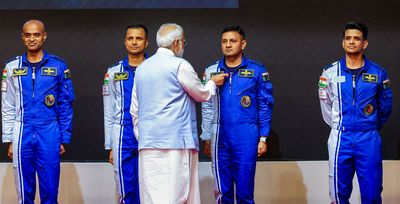From Mother Earth, she asked, “How does India appear from up there?” From the heavens, he replied, “Saare jahan se achha.”
Several million Indian hearts went into seventh heaven watching the chat between prime minister Indira Gandhi and Squadron Leader Rakesh Sharma who was orbiting the earth in a Russian space vehicle in 1984. For all you know, the dialogue had been scripted beforehand. No harm. It was played to perfection, and India had its moment of pride.
Narendra Modi’s Gaganyaan moment at Thiruvananthapuram last month too was played to the script. The four pilots, training to fly into zero gravity zones, took in the gravity of the moment. As they stood in smart attention, Modi presented them with astronaut wings, and later introduced them as India’s four shakti. A billion and more hearts flew to seventh heaven.
Ceremonies of the state are scripted to perfection. The names of the foursome—Group Captains Prashanth Nair, Ajit Krishnan, Angad Pratap and Wing Commander Shubhanshu Shukla—had been kept under wraps for full four years when they were training in Russia and India. That added to the moment’s solemn suspense.
A good script lends dignity to the event. It has risks, too. The whole thing can end in disaster, if one player strays from the script. It happened once, delaying Rakesh Sharma’s flight by a few years.
The story goes that Soviet supremo Leonid Brezhnev thought he could make a grand offer of a free space ride to an Indian in a Russian vehicle. To make the announcement with a flourish, he chose the lunch he was hosting in visiting prime minister Morarji Desai’s honour. Prompt came the reply from the old man—“not a particularly good idea!”
Even the hands of the Kremlin clock would have frozen. Brezhnev’s “unlit cigarette fell off his lips,” writes T.P. Sreenivasan in his book Words, Words, Words: Adventures in Diplomacy. Desai had a queasy logic: several boys would have to be trained, but only one would fly; why waste time and money? Only after the return of Indira in 1980 was the proposal revived, and Sharma flew in a Soyuz rocket to space, recalls Sreenivasan.
Indeed, more had to train for one Sharma to fly. They were actually a gang of four. Ravish Malhotra was there till the final stage of training, but missed the bus. He would retire as an air commodore in 1995. Then there was a team B— few still know about them—who too had trained with Rakesh and Ravish. Sadly, the eldest of the four, Subhash Mittal, passed away in 1986.
The fourth had a colourful career before and after his near-cosmonaut days. He had been flying the MiG-25, the world’s fastest (three times faster than sound) and highest-flying plane. I had the thrill of chatting him up 22 years ago about his supersecret plane that had made legends in the skies over Europe, West Asia and South Asia (THE WEEK, Sept 29, 2002). He was then a radio jockey, and is now a film and serial star. Even after earning fame as Emperor Akbar’s uncle Bairam Khan in Jodhaa Akbar, Wing Commander Yogesh Suri likes to be called by his old call sign Yuri.
This time, too, all four are not likely to fly. Gaganyaan can seat only three; perhaps one might be sent to ride in an American vehicle.
What would we call the four? Rakesh Sharma was called a cosmonaut since he flew with the Russians. The more common English word is astronaut, preferred by the Americans and the Europeans. The Chinese call theirs taikonauts. We in the media have already started calling our boys gagannauts. Or does Modi have another name in a script up his sleeve?
Why not vyomanaut?
prasannan@theweek.in


